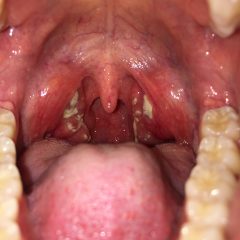Bowel Perforation complicating an incarcerated inguinal hernia
History of present illness:
A 51-year-old male presents complaining of increasing right groin pain and an enlarging bulge. Symptoms started as a “bubble” 6 weeks prior to presentation. One week prior to presentation, thinking the bulge was an abscess, the patient attempted to “pop” the bulge with a sewing needle, the needle became lodged in the site and he attempted retrieval with a second sewing needle, which also became lodged. No purulent material was obtained.
The patient denied any nausea, vomiting or constipation as well as any fevers or urinary symptoms. His abdomen was soft, non-tender, non-distended with active bowel sounds. The groin exam demonstrated an incarcerated right inguinal hernia and cellulitis of the right hemiscrotum with associated induration and tenderness.
Significant findings:
The AP and lateral pelvis x-rays revealed two sewing needles, 60 mm in length, within the soft tissue over the anterior right lower hemipelvis. In addition, the AP view showed emphysema involving the right hemiscrotum (arrow), concerning for perforated bowel.
Discussion:
Groin hernias have a lifetime risk of 27% for men and 3% for women and the incidence increases with age.1 Groin hernias can be either direct or indirect, and inguinal or femoral. The distinction is made during surgery. Femoral hernias make up only 5% of groin hernias but are more common in women.1 Concerning complications include incarceration, in which a hernia cannot be reduced, and strangulation in which vascular compromise occurs.1 Incarcerated hernias often present with a painful, tender mass and are difficult to distinguish from strangulation. Patients with strangulation may present with fevers and peritonitis. The overlying skin may also be red.2
The percentage of patients presenting with strangulation varies by region. Western developed countries report only 1%-3% of patients presenting as surgical emergencies whereas in Africa the percentage can be as high as 26%. This difference is thought to represent the availability of elective hernia repair in developed countries.3 The differential diagnosis for a groin mass includes: an abscess, lymphadenopathy and soft tissue tumors.1
In this case, the patient attempted to drain the suspected abscess with a needle, resulting in bowel perforation. The sensitivity for plain abdominal radiographs to detect needles in the peritoneal cavity varies by needle size. In a study of retained surgical needles, radiographs had a sensitivity of 99% for needle size greater than 25 mm.4 Although plain radiographs are not as sensitive as multi-detector computed tomography in the detection of free air, a recent retrospective study showed a sensitivity of 80.4%. The study was limited in that only 8.8% of perforations involved the small bowel or colon.5 Due to free air seen on x-ray, the patient was taken to the operating room where a cecal perforation was noted in addition to the incarcerated inguinal hernia.
Topics:
Inguinal Hernia, Incarceration, Bowel Perforation.
References:
- Fitzgibbons RJ, Forse RA. Groin hernias in adults. N Engl J Med. 2015;372:756-763. doi: 10.1056/NEJMcp1404068
- Aubin CD. Hernias. In: Adams JG, Barton ED, Collings JL, DeBlieux PM, Gisondi MA, Nadel ES, eds. Emergency Medicine: Clinical Essentials. 2nd 2013; 315-324.
- Ohene-Yeboah M, Dally CK, Strangulated inguinal hernia in adult males in Kumasi. Ghana Med J. 2014;48(2):101-105. doi: 10.4314/gmj.v48i2.8
- Ponrartana S, Coakley FV, Yeh BM, Breiman RS, Qayyum A, Joe BN, et al. Accuracy of plain abdominal radiographs in the detection of retained surgical needles in the peritoneal cavity. Ann Surg. 2008;247(1):8-12. doi: 10.1097/SLA.0b013e31812eeca5
- Chiu YH, Chen JD, Tiu CM, Chou YH, Yen DH, Huang CI, et al. Reappraisal of radiographic signs of pneumoperitoneum at emergency department. Am J Emerg Med. 2009;27:320-327. doi: 10.1016/j.ajem.2008.03.004




